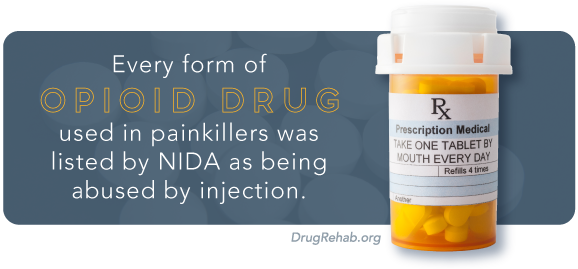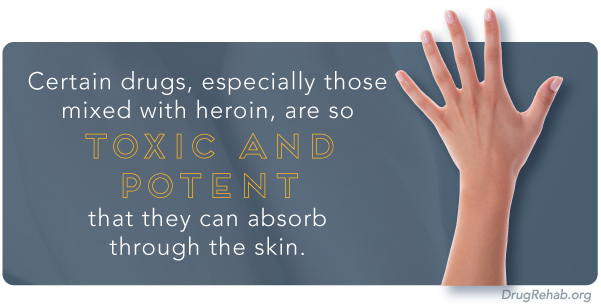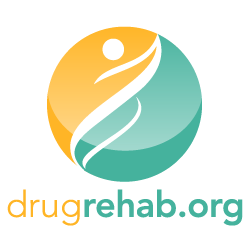
Intravenous, or IV drug use is the most common form of injection drug use. Users liquify and inject various drugs of abuse directly into their veins. The IV method requires certain tools called paraphernalia. These items can make this dangerous habit easier to spot. Over time, the drug user will begin to exhibit physical symptoms of IV drug use, such as scarred or collapsed veins. This method is highly dangerous, and can lead to addiction, disease (HIV/AIDS), coma, overdose, and death.
At a certain point in time, drug use can be surprisingly easy to hide. As use persists, however, it becomes increasingly difficult to cover up the signs of abuse. This is especially true with IV drug use, due to the method’s highly invasive nature.
What Types Of Drugs Do People Inject Intravenously?
While heroin is the most notorious drug used this way, you may be surprised to learn that drug abusers administer a wide variety of other drugs by this method. Cocaine (including crack), methamphetamine, and morphine are also frequently abused this way. Combining cocaine and heroin, or “speedballing,” is a common practice with recreational drug users.

The National Institute on Drug Abuse (NIDA) writes that the following drugs of abuse are also injected:
- Anabolic steroids
- Bath salts (synthetic cathinones)
- DMT
- Flakka
- Ketamine
- PCP
Additionally, and quite dangerously, a variety of prescription drugs are also used this way. Most of these medications come in a pill or tablet form which requires users to crush and liquify the drug.
Every form of opioid drug used in painkillers was listed by NIDA as being abused by injection. Examples include:
- Hydromorphone (Dilaudid)
- Meperidine (Demerol)
- Oxycodone (OxyContin)
Certain sedatives are also injected, such as:
- Barbiturates
- Benzodiazepines
- “Z-drugs” (sleeping medications)
Prescription stimulants, such as those used to treat ADHD, are frequently abused this way, including:
- Amphetamine (Adderall)
- Methylphenidate (Ritalin)
With the rise of prescription drug abuse, commonly abused medications are increasingly being manufactured with safeguards in place. These are designed to deter abuse by injection by making it more difficult.
What Are The Behavioral Cues Of IV Drug Use?
The general behavioral cues of IV drug abuse and addiction will be similar and may include a person:
- Becoming evasive or upset if you ask about drug use
- Being unable to stop or limit drug use
- Going out of their way to find and use the drug
- Experiencing intense urges or cravings to use the drug
- Ignoring important responsibilities at work or school
- Losing interest in their favorite things
- Needing more of the drug than before to feel good (tolerance)
- Pushing people away and/or suddenly having new “friends” (fellow drug users)
- Spending money they can’t afford on the drug
- Thinking or talking excessively about the substance
- Hoarding, hiding, or stealing the drug
- Doctor shopping to procure more of the drug (in the case of prescription medications)
- Wearing long sleeves to cover up track marks even in warm weather
Despite being administered the same way, each drug of abuse has a different method of action. Because of this, physical and mental signs of abuse will vary. Drugs within the same class, such as opioids, will closely mimic each other. But on the other hand, stimulants such as cocaine would create a quite different impact in comparison to the depressant effects of an opioid.
What Is Drug Paraphernalia?
 When a drug abuser injects a drug, they need certain equipment. These items are collectively termed paraphernalia. Finding these objects can be a telltale sign that a person is engaging in IV drug use. The most obvious one would be a syringe (insulin syringes are frequently used). You might also find pill bottles, baggies, or balloons which contained the drugs.
When a drug abuser injects a drug, they need certain equipment. These items are collectively termed paraphernalia. Finding these objects can be a telltale sign that a person is engaging in IV drug use. The most obvious one would be a syringe (insulin syringes are frequently used). You might also find pill bottles, baggies, or balloons which contained the drugs.
It can be hard for a person to inject into the vein on their own. For this reason, some people choose to modify the syringe. If this occurs, they may replace the plunger with a bulb, such as those from an eyedropper or baby pacifier.
Paraphernalia may include:
- Alcohol swabs to sterilize the injection site.
- Material to filter the liquidized drug through (cigarette filters, cotton balls, or sterile filters which are made for this purpose).
- Hard surface with powdery residue on it (from crushing and cutting pills). Mirrors are often used and may be in a strange place like on a bed or on the floor.
- Razor blades (used to do the above).
- An acidic agent (lemon juice, citric acid, or Vitamin C). These are used to help dissolve certain drugs.
- A spoon or pop can for “cooking” or liquefying the drug. It may appear burnt.
- A lighter used for heating the drug.
- A tourniquet, such as a piece of rubbing tubing or a belt. These are used to enlarge the vein and make it more pronounced for injection.
- Though more rare, some people may keep a “sharps bin” (a container for used needles) on hand.
Typically a person keeps these items all together in a kit. This may be a small box or bag. It is usually hidden out of sight, such as under the bed, in the closet, etc.
Be very careful when you’re touching these objects. In fact, we recommend that you not touch the items inside of the kit for any reason unless you absolutely have to. Injection needles can carry serious diseases. Also, certain drugs, especially those mixed with heroin, are so toxic and potent that they can absorb through the skin. This can lead to overdose and even death.
What Are The Physical Signs Of IV Drug Use?
Again, injecting a drug directly into your vein is very invasive. People most commonly inject into their forearm, however, users may also choose locations on their legs, neck, hands, feet, and groin. Soon after use, unhealed needle marks, scabs, or bruising may be evident.
Over time, a person’s skin and veins can become scarred, inflamed, and infected. They may even develop abscesses or ulcers. Receptively injecting a drug into the same site can cause vascular scarring. This is referred to as a “track mark.”

Infections can become severe and lead to cellulitis or necrotizing fasciitis, which is sometimes referred to as a “flesh-eating disease.” In both, the skin will become red, swollen, and warm. Cellulitis may make skin appear taut and glossy. In the latter, patches of skin may become dark as tissues begin to die. Both conditions are serious and require prompt medical treatment.
According to Journal of Clinical & Experimental Dermatology Research, users sometimes heat their needles just prior to injection. This leaves a dark, sooty residue at the injection site, referred to as a “sooting tattoo.” The article asserts that some people will actually get an inked tattoo to cover this up. This practice is used to hide the damage from injection sites in general.
If You See Signs Of IV Drug Abuse, Get Help
If you witness a combination of any of these signs within your loved one, be on guard: they could be abusing drugs. Don’t ignore these signs. The earlier you’re able to support them in making steps towards treatment, the better. We can help you with this. DrugRehab.org can give you more information on specific drugs of abuse and the best treatment centers for them. Reach out to one of our treatment specialists and let us help you today.


